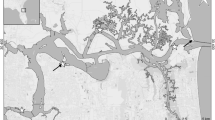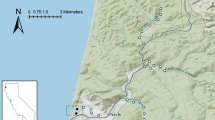Abstract
Wetland plays important roles in river ecosystems. However, the area of wetland decreased considerably due to excessive construction and land use with economic development. For recovering river ecosystem, the wetland named Azame-no-se was restored in the Matsuura River, which is located in Saga Prefecture in Kyushu, Japan. Anodonta lauta, a freshwater mussel that lives in the lentic water of wetlands, played an important role in a river. However, A. lauta lost its habitat and became endangered in Japan. A. lauta was found surviving in the Azame-no-se Wetland; however, only recently researchers have begun to understand the mechanisms that allow this mussel to now prosper there. This study investigated mussel survival mechanisms in the restored Azame-no-se Wetland. Mussel motility, coverage of Trapa japonica (an aquatic plant) and water quality were investigated in three pools (Shitaike, Ueike, and Tomboike) of the Azame-no-se Wetland and in still water in the Matsuura River (May 2011–2012). A feeding behavior experiment was also conducted in Ueike Pool two times in 2012. Results showed that this pool had abundant nutrients (thanks to its high flood frequency) that supported the growth of certain phytoplankton species possibly important for A. lauta. Dissolved oxygen was another important factor. Although Shitaike Pool shared similar conditions with Ueike Pool, the mussel became extinct when the dissolved oxygen decreased because of the lush growth of T. japonica in Shitaike Pool. This study indicated that the factors essential for A. lauta’ survival in the restored wetland were dissolved oxygen (DO), nutrients, and phytoplankton species. These results could be helpful for understanding functions of restored wetland and further offer suggestions for managing river–floodplain system.










Similar content being viewed by others
References
Agostinho AA, Bini LM, Gomes LC, Júlio Junior HC, Pavanelli CS, Agostinho CS (2004) Fish assemblages. In: Thomaz SM, Agostinho AA, Hahn NS (eds) The upper Paraná river and its floodplain: physical aspects, ecology and conservation. Backhuys Publishers, Leiden, pp 223–246
Boltovskoy D, Izaguirre I, Correa N (1995) Feeding selectivity of Corbicula fluminea (bivalvia) on natural phytoplankton. Hydrobiologia 312(3):171–182
Brammer ES (1979) Exclusion of phytoplankton in the proximity of dominant water-soldier (Stratiotes aloides). Freshiwat Biol 9:233–248
Brinson MM, Malvarez AI (2002) Temperate freshwater wetlands: types, status, and threats. Environ Conserv 29:115–133
Bykova O, Laursen A, Bostan V, Bautista J, McCarthy L (2006) Do zebra mussels (Dreissena polymorpha) alter lake water chemistry in a way that favours microcystis growth? Sci Total Environ 371:362–372
Espinosa EP, Allam B, Ford SE (2008) Particle selection in the ribbed mussel Geukensia demissa and the eastern oyster Crassostrea virginica: effect of microalgae growth stage. Estuar Coast Shelf Sci 79:1–6
Hayashi H, Shimatani Y, Shigematsu K, Nishihiro J, Ikematsu S, Kawaguchi Y (2012) A study of seed dispersal by flood flow in and artificially restored floodplain. Landscape Ecol Eng 8:129–143
Howard JK, Cuffey KM (2006) The functional role of native freshwater mussels in the fluvial benthic environment. Freshw Biol 51:460–474
Hu HJ, Li R, Wei YX et al. (1979) Chinese Fresh Algae [in Chinese]. Sci-tech Publishers, Shanghai
Inakuma Y, Hayashi H, Tsujimoto Y, Shimatani Y (2013) Settling characteristics and the limiting factor of habitat distribution of unionoida mussels in the Matsuura river. Journal of JSCE B1 69(4):1297–1302
Jana P, Gruberts D, Škute A, Druvietis I (2007) Impact of two different flood pulses on planktonic communities of the largest floodplain lakes of the daugava river (Latvia). Hydrobiologia 592:303–314
Jones RC (1990) The effect of submersed aquatic vegetation on phytoplankton and water quality in the tidal freshiwater Potomac river. J Freshwat Ecol 5:279–289
Junk WJ, Wantzen KM (2004) The flood pulse concept: new aspects, approaches and applications—an update. In: Welcomme R L, Petr T (eds) Proceedings of the Second International Symposium on the Management of Large Rivers for Fisheries. FAO Regional Office for Asia and the Pacific, RAP Publication, Bangkok 2:117–149
Kakino J (1986) Death of shellfish in rear Tokyo bay. Fisheries engineering 23:41–47
Kannan V, Job SV (1980) Seasonal and diurnal changes of chlorophyll in a tropical fresh water impoundment. Hydrobiologia 69(3):267–271
Kim AM, Havel J (2007) Hydrology and local environmental factors influencing zooplankton communities in floodplain ponds. Wetland 27(4):864–872
Kondolf GM (1995) Five elements for effective evaluation of stream restoration. Restor Ecol 3:133–136
Lindholm M, Hessen D, Mosepele K, Wolski P (2007) Food webs and energy fluxes on a seasonal floodplain: the influence of flood size. Wetland 27(4):775–784
Malmqvist B, Rundle S (2002) Threats to the running water ecosystems of the world. Environ Conserv 29:134–153
Middleton BA (1999) Wetland restoration, flood pulsing, and disturbance dynamics. John Wiley and Sons, Inc., New York, 5
Moss B (1990) Engineering and biological approaches to the restoration from eutrophication of shallow lakes in which aquatic plant communities are important components. Hydrobiologia 200(201):367–377
Moss B, Balls H, Irvin K, Stansfield J (1986) Restoration of two lowland lakes by isolation from nutrient- rich water sources with and without removal of sediment. J applEcol 23:391–414
Muylaert K, Vyverman W (2006) Impact of a flood event on the planktonic food web of the Schelde estuary (Belgium) in spring 1998. Hydrobiologia 559:385–394
Nakamura K, Klement T, Kunihiko A (2006) River and wetland restoration: lessons from Japan. Bioscience 56(5):419–429
Negishi J, Kayaba Y, Ysukahara K, Miwa Y (2008) Unionoid mussels as imperiled indicator organisms: habitat degradation prosesses and restoration approaches. Ecol Civil Eng 11(2):195–211
Negishi J, Sagawa S, Kayaba Y, Sanada S, Kume M, Miyashita T (2012) Mussel responses to flood pulse frequency: the importance of local habitat. Freshw Biol 57(7):1500–1511
Nienhuis PH, Leuven RSEW (2001) River restoration and flood protection: controversy or synergism? Hydrobiologia 444:85–99
Oliver LR, Seed R, Reynolds B (2008) The effect of high flow events on mussels (Mytilus edulis) in the Conwy estuary, North Wales, UK. Hydrobiologia 597(1):117–127
Palmer MA, Bernhardt ES, Allan JD et al (2005) Standards for ecologically successful river restoration. J Appl Ecol 42:208–217
Pokorny J, Kvet I, Ondok IP, Toul Z, Ostry I (1984) Production-ecological analysis of a plant community dominated by Wlodea Canadensis Michx. Aquat Bot 19:263–292
Reeders HH, de Vaate AB, Slim FJ (1989) The filtration rate of Dreissena polymorpha (Bivalve) in three Dutch lakes with reference to biological water quality management. Freshwater Biol 22:133–141
Stybel N, Fenske C, Schernewski G (2009) Mussel cultivation to improve water quality in the Szczecin Lagoon. J Coast Res 56:1459–1463
Takamura N, Kadono Y, Fukushima M, Nakagawa M, Kim BH (2003) Effects of aquatic macrophytes on water quality and phytoplankton communities in shallow lakes. Ecol Res 18(4):381–395
ter Braak CJF (1987) The analysis of vegetation-environment relationships by canonical correspondence analysis. Vegetatio 69:69–77
Turkoglu M, Erdogan Y (2010) Diurnal variations of summer phytoplankton and interactions some physicochemical characteristics under eutrophication in the Dardanelles. Turk Journal of Biol 34:211–225
Vanderploeg HA, Liebig JR, Carmichael WW, Agy MA, Johengen TH, Fahnenstiel GL, Nalepa TF (2001) Zebra mussel (Dreissena polymorpha) selective filtration promoted toxic Microcystis bloom in Saginaw Bay (Lake Huron) and Lake Erie. Can J Fish Aquat Sci 58(6):208–221
Watanabe M, Koyama T (2010) The proposal for nutrient concentration control employing nutrient uptake and release by T. japonica inhabiting lake Izunuma. J of Japan Society on Water Environ 33(5):57–61
Watters GT (1999) Freshwater mussels and water quality: A review of effects of hydrologic and instream habitat alterations. Proceedings of the First Freshiwater Mollusk Conservation Society Symposium 1:261–274
Wilson J (2008) Nutrient and phytoplankton responses to a flood event in a series of interconnected coastal lakes: Myall Lakes Australia. Hydrobiologia 608(1):21–34
Wu QL, Chen YW, Liu ZW (2005) Filtering capacity of Anodonta woodiana and its feeding selectivity on phytoplankton. Chin J Appl Ecol 16(12):2423–2427
Yamagishi T (2007) Encyclopedia Genera of Freshwater Algae (in Japanese). Uchida Rokakuho, Tokyo
Yamawaki M (2000) Naturnaher Wasser und Strassenbau [in Japanese]. Shinzansya Sci-tech, Tokyo
Zeng T, Ziegelgruber KL, Chin YP, Arnold WA (2011) Pesticide processing potential in prairie pothole porewaters. Environ Sci Technol 45(16):6814–6822
Acknowledgments
The authors gratefully acknowledge Assistant Professor Hiroki Iyooka of Fukuoka University for planning the mussel feeding experiment and for supplying experimental equipment.
Author information
Authors and Affiliations
Corresponding author
Rights and permissions
About this article
Cite this article
Liu, J., Hayashi, H., Inakuma, Y. et al. Factors of Water Quality and Feeding Environment for a Freshwater mussel’s (Anodonta lauta) Survival in a Restored Wetland. Wetlands 34, 865–876 (2014). https://doi.org/10.1007/s13157-014-0549-7
Received:
Accepted:
Published:
Issue Date:
DOI: https://doi.org/10.1007/s13157-014-0549-7




